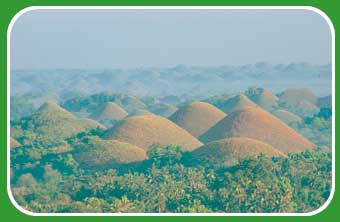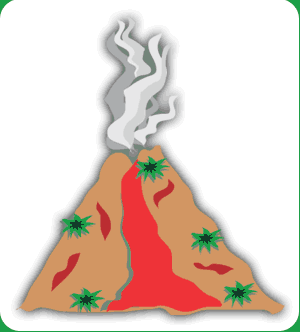| |
The Land
Across lowland coastal plains and mountainous interiors, the
islands of The Philippines have the richest biodiversity
on earth. There are 510 species of mammals, birds, frogs and
lizards that are only found in the Philippines. In comparison,
Brazil has 725 unique species but it is 28 times bigger. But
like many countries, this biodiversity is under threat. People
are clearing natural habitats to make way for new roads and
settlements, and to use natural resources like timber and
minerals. In the 1950s, three quarters of The Philippines
was covered by primary
forest. Today, forest cover has dwindled to only a third
of the land.

� Simon Scoones/Worldaware.
|
The
Chocolate Hills are one of the more unusual landforms
in The Philippines. These egg-shaped hills on Bohol island
get their nickname from their parched, brown colour during
the dry season. It is likely that they were once limestone
deposits beneath the sea, uplifted by the movement of
plates and then smoothed by wind and rainwater erosion.
|

The people of the Philippines experience more natural disasters
than any other country...
- There are 17 active
volcanoes in The Philippines.
- Since 1975, there
have been twelve earthquakes and six volcanic eruptions.
- Over one million
people were affected by floods in 2000.
- The Philippines has
an average of 19 typhoons a year, causing flash floods and
considerable damage to farmland and property.
- Between 1975-2000,
there were 250 natural disasters causing 37,000 deaths.
 for
a table that shows the worst ten according to the numbers
of people killed. for
a table that shows the worst ten according to the numbers
of people killed.
 to find out how the number of natural disasters in The Philippines
compares to other countries in south-east Asia.
to find out how the number of natural disasters in The Philippines
compares to other countries in south-east Asia.
How can the actions of
people make some of these natural disasters even worse? 
Pinatubo Ten Years On
 |
Mount
Pinatubo's eruption on June 14th 1991 was one of the largest
of the 20th century. 500,000 people living in the shadow
of the volcano are still affected by this natural disaster.
To find out more,
 |
The
Climate
 Lying
5-15° north of the equator, the climate is hot and
humid all year round. Although the sea influences the
climate of individual islands to some extent, all the
islands have two seasons during the year, a dry season
from January to June, and a wet season from July to December.
Like much of northern Australia, The Philippines suffered
a drought in 1999 when it should have been the wet season.
This is because of a change in the behaviour of the Trade
Winds that blow across the Pacific Ocean known as El Nino.
To find out more about El Nino and the reverse phenomenon,
La Nina, visit The Pacific Marine Environmental Laboratory
website, www.pmel.noaa.gov/tao/elnino/nino-home.html Lying
5-15° north of the equator, the climate is hot and
humid all year round. Although the sea influences the
climate of individual islands to some extent, all the
islands have two seasons during the year, a dry season
from January to June, and a wet season from July to December.
Like much of northern Australia, The Philippines suffered
a drought in 1999 when it should have been the wet season.
This is because of a change in the behaviour of the Trade
Winds that blow across the Pacific Ocean known as El Nino.
To find out more about El Nino and the reverse phenomenon,
La Nina, visit The Pacific Marine Environmental Laboratory
website, www.pmel.noaa.gov/tao/elnino/nino-home.html
|
|
|





